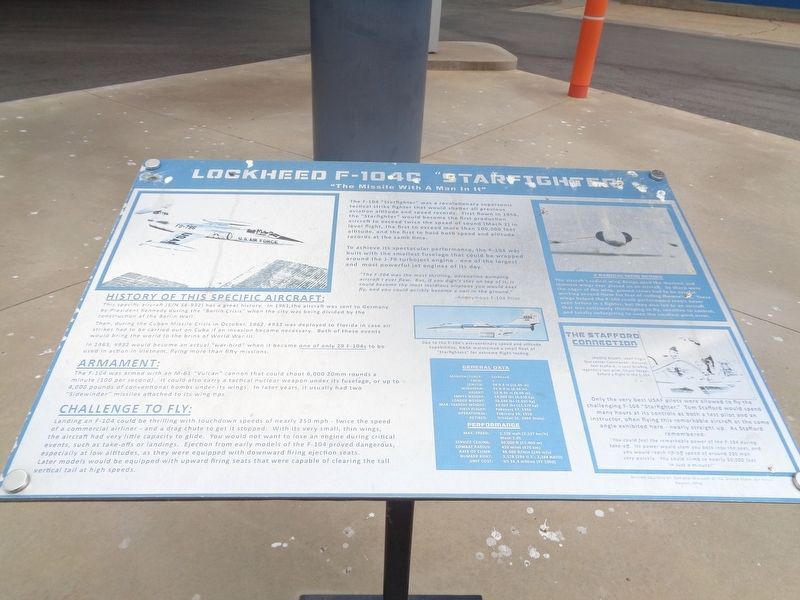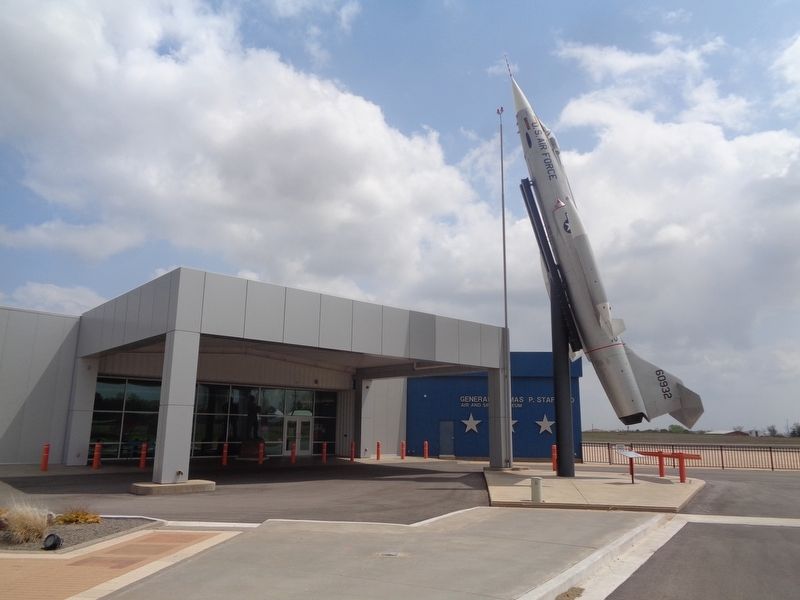Weatherford in Custer County, Oklahoma — The American South (West South Central)
Lockheed F-104C "Starfighter"
"The Missile With a Man In It"
To achieve its spectacular performance, the F-104 was built with the smallest fuselage that could be wrapped around the J-79 turboject engine - one of the largest and most powerful jet engines of its day.
"The F-104 was the most thrilling, adrenaline-pumping aircraft I ever flew. But, if you didn't stay on top of it, it could become the most insidious airplane you would ever fly, and you could quickly become a nail in the ground."
-Anonymous F-104 Pilot
History of this specific aircraft:
This specific aircraft (S/N 56-932) has a great history. In 1961, the aircraft was sent to Germany by President Kennedy during the "Berlin Crisis" when the city was being divided by the construction of the Berlin Wall.
Then, during the Cuban Missile Crisis in October, 1962, #932 was deployed to Florida in case air strikes had to be carried out on Cuba if an invasion became necessary. Both of these events would bring the world to the brink of World War III.
In 1965, #932 would become an actual "war-bird" when it became one of only 29 F-104s to be used in action in Vietnam, flying more than fifty missions.
Armament:
The F-104 was armed with an M-61 "Vulcan" cannon that could shoot 6,000 20mm rounds a minute (100 per second). It could also carry a tactical nuclear weapon under its fuselage, or up to 4,000 pounds of conventional bombs under its wings. In later years, it usually had two "sidewinder" missiles attached to its wing tips.
Challenge to Fly:
Landing an F-104 could be thrilling with touchdown speeds of nearly 250 mph - twice the speed of a commercial airliner - and a drag chute to get it stopped. With its very small, thin wings, the aircraft had very little capacity to glide. You would not want to lose an engine during critical events, such as take-offs or landings. Ejection from early models of the F-104 proved dangerous, especially at low altitudes, as they were equipped with downward firing ejection seats. Later models would be equipped with upward firing seats that were capable of clearing the tall vertical tail at high speeds.
(photo caption:)
Due to the F-104's extraordinary speed and altitude capabilities, NASA maintained a small fleet
of "Starfighters" for extreme flight testing.
(sidebars:)
A Radical Wing Design
The aircraft's radical wing design used the shortest and thinnest wings ever placed on an aircraft. So sharp were the edges of the wing, ground crews had to be careful working around them for fear of cutting themselves. These wings helped the F-104 reach performance levels never seen before in a fighter, but they also led to an aircraft that was extremely challenging to fly, sensitive to control, and totally unforgiving to even the smallest pilot error.
The Stafford Connection
Only the very best USAF pilots were allowed to fly the challenging F-104 "Starfighter." Tom Stafford would spend many hours at its controls as both a test pilot and an instructor, often flying this remarkable aircraft at the same angle exhibited here - nearly straight up. As Stafford remembered:
"You could feel the remarkable power of the F-104 during take-off. Its power would slam you back into the seat, and you reach lift-off speed of around 220 mph very quickly. You could climb to nearly 50,000 feet in just a minute!"
General Data
Manufacturer: Lockheed
Crew: 1
Length: 54 ft 8 in (16.66 m)
Wingspan: 21 ft 9 in (6.36 m)
Height: 13 ft 86 in (4.09 m)
Empty weight: 14,000 lbs (6,350 kg)
Loaded weight: 20,640 lbs (9,365 kg)
Max. takeoff weight: 29,029 lbs (13,170 kg)
First flight: February 17, 1956
Operational: February 20, 1958
Retired: October 31, 2004 (Italy)
Performance
Max. speed: 1,328 mph (2,137 km/h) Mach 2.01
Service ceiling: 50,000 ft (15,000 m)
Combat radius: 420 miles (670 km)
Rate of climb: 48,000 ft/min (244 m/s)
Number built: 2,578 (294 U.S.; 2,284 NATO)
Unit cost: US $1.4 million (FY 1960)
Topics and series. This historical marker is listed in these topic lists: Air & Space • War, Cold. In addition, it is included in the Former U.S. Presidents: #35 John F. Kennedy series list. A significant historical date for this entry is February 17, 1956.
Location. 35° 32.648′ N, 98° 40.214′ W. Marker is in Weatherford, Oklahoma, in Custer County. Marker is at the intersection of Logan Road and Jim Cobb Drive, on the right when traveling east on Logan Road. Marker is outside the Stafford Air & Space Museum. Touch for map. Marker is at or near this postal address: 3000 Logan Rd, Weatherford OK 73096, United States of America. Touch for directions.
Other nearby markers. At least 8 other markers are within 6 miles of this marker, measured as the crow flies. Lt. Gen. Thomas P. Stafford (a few steps from this marker); Fairchild-Republic A-10 "Thunderbolt II" (a few steps from this marker); Apollo Command Module (a few steps from this marker); Lockheed T-33 "Shooting Star" (within shouting distance of this marker); McDonnell-Douglas F-4C Phantom II (approx. half a mile away); Provine/Hamons' Station (approx. 4.6 miles away); The Baldwin Bridge (approx. 5.2 miles away); Hydro Veterans Memorial (approx. 5.7 miles away). Touch for a list and map of all markers in Weatherford.
Also see . . .
1. Lockheed F-104 Starfighter on Wikipedia. (Submitted on June 19, 2021, by Jason Voigt of Glen Carbon, Illinois.)
2. Stafford Air & Space Museum. Official website (Submitted on June 19, 2021, by Jason Voigt of Glen Carbon, Illinois.)
Credits. This page was last revised on June 19, 2021. It was originally submitted on June 19, 2021, by Jason Voigt of Glen Carbon, Illinois. This page has been viewed 128 times since then and 12 times this year. Photos: 1, 2. submitted on June 19, 2021, by Jason Voigt of Glen Carbon, Illinois.

